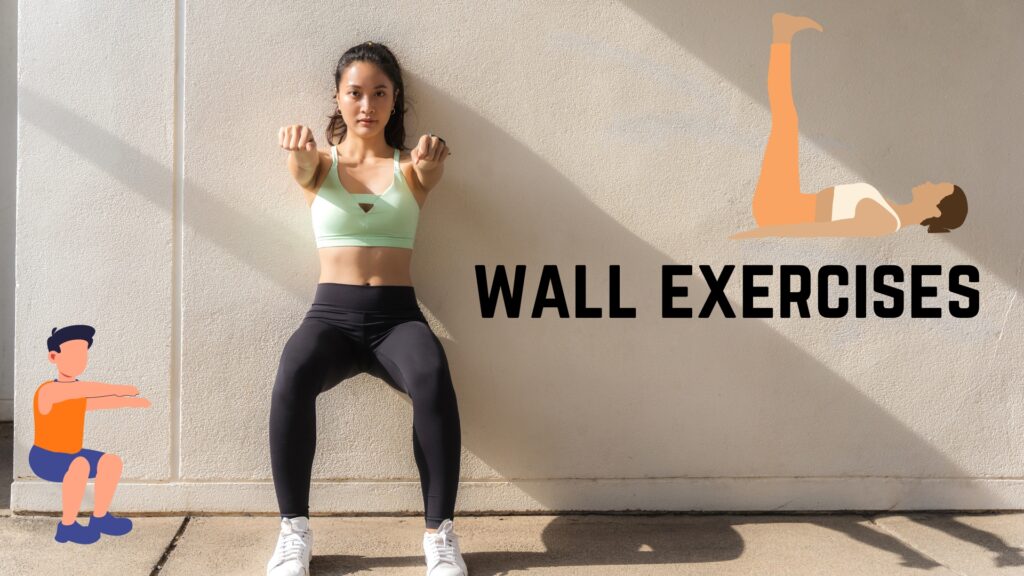Looking to shake up your workout routine and challenge your muscles in a new way? Look no further than wall exercises. These unique moves utilize a simple wall to provide resistance and stability, resulting in a robust workout that targets multiple muscle groups. In this blog post, we will explore four wall exercises that are sure to take your fitness to the next level. From split squats to wall pushups, bridges, and wall sit clams, these exercises are designed to strengthen your entire body while adding a fun twist to your workout routine.
The Fundamentals of Wall Workouts
Wall exercises stand out in the fitness realm due to their ability to leverage a simple architectural feature—the wall—to ramp up the effectiveness of your workout. By integrating a wall into your exercise routine, you tap into an innovative method of adding resistance and enhancing stability across various movements. This unique approach allows for a more dynamic engagement of muscle groups, promoting strength, endurance, and flexibility. Wall workouts cater to a broad spectrum of fitness enthusiasts, from those just embarking on their fitness journey to seasoned athletes seeking to intensify their training regimen. The beauty of wall exercises lies in their simplicity and versatility; they do not require expensive equipment or extensive space, making them accessible to anyone, anywhere. Engaging in wall workouts can lead to significant improvements in balance and posture while simultaneously offering the challenge needed to push your limits and achieve new fitness milestones. By incorporating exercises such as wall pushups, bridges, and squats, individuals can create a comprehensive workout that effectively targets both the upper and lower body, as well as the core, ensuring a well-rounded fitness routine.
Preparing for Your Wall Workout
To ensure a successful and injury-free wall workout, initiating the session with an appropriate warm-up routine is paramount. Begin with dynamic activities that elevate your heart rate and activate the muscle groups you’ll be engaging. A brisk five-minute walk or a series of jumping jacks can effectively prepare your body for the workout ahead. Following this, engage in dynamic stretches to enhance muscle flexibility and range of motion. Focus on dynamic stretching exercises that mimic the movements of the wall exercises you plan to perform. This can include leg swings to loosen the hips and lower body, arm circles to warm up the shoulders, and gentle spinal rotations to activate the core. Such a preparatory regimen not only primes your muscles for the strenuous activity to follow but also mentally prepares you for the workout, ensuring you’re fully focused and ready to maximize the benefits of your wall exercises. Remember, the goal of this preparation phase is to increase blood flow to the muscles and reduce the risk of strain or injury, setting the stage for a productive and enjoyable workout experience.
Split Squat With Your Back Leg on the Wall
To initiate this dynamic lower body exercise, position yourself several feet away from a wall, facing the opposite direction. Carefully place the toes of your back foot against the wall at a comfortable height. This positioning should allow you to maintain balance while performing the movement. Bend your front knee and lower your body into a lunge, ensuring your front thigh is parallel to the floor, and your knee does not extend past your toes. Your back knee should come close to the ground, creating a strong stretch through the front of your back leg, which is elevated against the wall. Press firmly through the heel of your front foot, engaging your quads, glutes, and hamstrings as you rise back to the starting position. This exercise not only enhances lower body strength but also improves balance and core stability by engaging the abdominal muscles to maintain posture throughout the movement. Remember to keep your torso upright and your gaze forward, avoiding any leaning forward or backward, to ensure maximum efficacy of the movement. Alternate legs after completing the desired number of repetitions to ensure balanced muscle development on both sides of the body. This variation of the traditional split squat challenges your muscles in new ways, providing a refreshing twist to your lower body routine.
Enhancing Upper Body Strength With Wall Pushups
Wall pushups offer an accessible and effective way to fortify the muscles of the upper body, including the chest, shoulders, and triceps. To commence this exercise, position yourself an arm’s length away from a wall, palms placed against it slightly wider than shoulder-width apart. Carefully bend your elbows and lean your body toward the wall, maintaining a straight posture from your head down to your heels. Engage your core to stabilize your body throughout the movement. Press back against the wall until your arms are fully extended, focusing on the contraction of your chest and arm muscles. This variation of the traditional pushup is perfect for those who are new to fitness, recovering from an injury, or looking to add a low-impact option to their upper body regimen. It’s a scalable exercise, meaning you can adjust the difficulty by changing your distance from the wall or the speed at which you perform the pushups. Regularly incorporating wall pushups into your routine can lead to noticeable improvements in muscle tone and overall upper body strength, laying a solid foundation for more advanced exercises.
Bridge – An All-Level Core and Glute Challenge
Embark on a journey to strengthen your core and glutes with the bridge exercise, a versatile and effective movement perfect for individuals of all fitness levels. Begin by positioning yourself on the floor with your legs elevated against the wall, feet planted firmly and knees bent to form a right angle. Engage your core and glute muscles as you lift your hips off the ground, aiming to create a straight line from your knees to your shoulders. Ensure your lift comes from your glutes rather than your lower back to maximize the benefits of this exercise. As you elevate your hips, focus on the engagement of your core muscles, maintaining stability and control. Hold the position at the top for a few seconds before gently lowering your hips back to the floor. This movement not only targets the glutes and core but also aids in enhancing hip mobility and stability, making it a comprehensive exercise for improving overall functional fitness. Experiment with variations such as single-leg lifts to challenge yourself further and prevent plateauing. Incorporating the bridge into your wall workout routine can significantly contribute to building a stronger, more resilient lower body and core, essential for everyday movements and advanced fitness endeavors alike.
The Wall Sit Clam for Inner Thigh Strength
To begin the wall sit clam, an innovative exercise focusing on the inner thighs, glutes, and core, position yourself with your back flat against the wall. Your feet should be planted on the ground, hip-width apart, while your legs form a 90-degree angle. From this foundational wall sit stance, proceed by pressing your back into the wall for added stability. Carefully, open your knees outward as wide as comfortable, simulating the motion of a clamshell opening, hence the name “clam.” Ensure your feet remain in contact with each other, maximizing the engagement of the inner thigh muscles. Gradually bring your knees together, returning to the initial position. This movement not only isolates and strengthens the muscles of the inner thighs but also engages the core and glutes, contributing to improved stability and posture. It’s a strategic addition to any wall workout, effectively complementing the other exercises by focusing on the lower body’s often overlooked areas. Regular practice of the wall sit clam can enhance hip flexibility and contribute to a more balanced muscle development, crucial for both daily activities and athletic performance.
Must Read: Occipital Neuralgia Exercises for Instant Relief
Cooling Down and Stretching After Your Wall Workout
Completing your wall workout with a deliberate cool-down and stretching sequence is crucial for safeguarding your muscles and aiding in your recovery process. Initiate this phase by engaging in low-intensity activities, such as a gentle walk or a slow jog in place, for a few minutes to gradually lower your body’s heart rate. Following this, transition into stretching exercises that specifically target the muscles you’ve just worked. Prioritize stretches for your quads, hamstrings, calves, shoulders, and back, areas that often bear the brunt of wall exercises. Gentle, static stretches held for at least 20 seconds each can help to elongate the muscles, relieving tension and reducing the likelihood of post-exercise stiffness.
Pay close attention to your body’s signals during this phase; stretching should produce a feeling of elongation and relaxation in the muscles, never pain. For an enhanced stretching experience, you can utilize the wall as a support for certain stretches, such as calf stretches or gentle chest openers, to deepen the stretch without additional strain. Incorporating mindful breathing into your cool-down can further promote relaxation and recovery, encouraging a seamless transition from the intensity of your workout to a state of rest. By dedicating time to properly cool down and stretch, you invest in your body’s health, flexibility, and readiness for future workouts, making each wall exercise session more effective and enjoyable.



